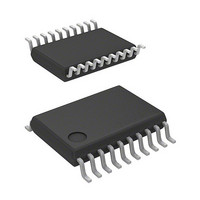R5F21324CNSP#U0 Renesas Electronics America, R5F21324CNSP#U0 Datasheet - Page 378

R5F21324CNSP#U0
Manufacturer Part Number
R5F21324CNSP#U0
Description
MCU 1KB FLASH 16K ROM 20-LSSOP
Manufacturer
Renesas Electronics America
Series
R8C/3x/32Cr
Datasheet
1.R5F21321CDSPU0.pdf
(605 pages)
Specifications of R5F21324CNSP#U0
Core Processor
R8C
Core Size
16/32-Bit
Speed
20MHz
Connectivity
I²C, LIN, SIO, SSU, UART/USART
Peripherals
POR, PWM, Voltage Detect, WDT
Number Of I /o
15
Program Memory Size
16KB (16K x 8)
Program Memory Type
FLASH
Ram Size
1.5K x 8
Voltage - Supply (vcc/vdd)
1.8 V ~ 5.5 V
Data Converters
A/D 4x10b
Oscillator Type
Internal
Operating Temperature
-20°C ~ 85°C
Package / Case
20-LSSOP
Lead Free Status / RoHS Status
Lead free / RoHS Compliant
Eeprom Size
-
- Current page: 378 of 605
- Download datasheet (6Mb)
R8C/32C Group
REJ09B0573-0100 Rev.1.00 Dec. 18, 2009
Page 349 of 573
22.5.3
22.5.4
The transfer clock is used to transmit and receive data as is shown in Figure 22.14 Transfer to U2RB Register
and Interrupt Timing.
The CSC bit in the U2SMR2 register is used to synchronize an internally generated clock (internal SCL2) and
an external clock supplied to the SCL2 pin. When the CSC bit is set to 1 (clock synchronization enabled), if a
falling edge on the SCL2 pin is detected while the internal SCL2 is high, the internal SCL2 goes low. The value
in the U2BRG register is reloaded and counting of the low-level intervals starts. If the internal SCL2 changes
state from low to high while the SCL2 pin is low, counting stops. If the SCL2 pin goes high, counting restarts.
In this way, the UART2 transfer clock is equivalent to AND of the internal SCL2 and the clock signal applied to
the SCL2 pin. The transfer clock works from a half cycle before the falling edge of the internal SCL2 1st bit to
the rising edge of the 9th bit. To use this function, select an internal clock for the transfer clock.
The SWC bit in the U2SMR2 register determines whether the SCL2 pin is fixed low or freed from low-level
output at the falling edge of the 9th clock pulse.
If the SCLHI bit in the U2SMR4 register is set to 1 (enabled), SCL2 output is turned off (placed in the high-
impedance state) when a stop condition is detected.
Setting the SWC2 bit in the U2SMR2 register to 1 (“L” output) makes it possible to forcibly output a low-level
signal from the SCL2 pin even while sending or receiving data. Setting the SWC2 bit to 0 (transfer clock)
allows the transfer clock to be output from or supplied to the SCL2 pin, instead of outputting a low-level signal.
If the SWC9 bit in the U2SMR4 register is set to 1 (SCL “L” hold enabled) when the CKPH bit in the U2SMR3
register is 1, the SCL2 pin is fixed low at the falling edge of the clock pulse next to the 9th. Setting the SWC9
bit to 0 (SCL “L” hold disabled) frees the SCL2 pin from low-level output.
The data written to bits b7 to b0 (D7 to D0) in the U2TB register is output in descending order from D7.
The 9th bit (D8) is ACK or NACK.
Set the initial value of SDA2 transmit output when IICM is set to 1 (I
U2MR register are set to 000b (serial interface disabled).
Bits DL2 to DL0 in the U2SMR3 register allow addition of no delays or a delay of 2 to 8 U2BRG count source
clock cycles to the SDA2 output.
Setting the SDHI bit in the U2SMR2 register to 1 (SDA output disabled) forcibly places the SDA2 pin in the
high-impedance state. Do not write to the SDHI bit at the rising edge of the UART2 transfer clock.
Transfer Clock
SDA Output
2
C mode) and bits SMD2 to SMD0 in the
22. Serial Interface (UART2)
Related parts for R5F21324CNSP#U0
Image
Part Number
Description
Manufacturer
Datasheet
Request
R

Part Number:
Description:
KIT STARTER FOR M16C/29
Manufacturer:
Renesas Electronics America
Datasheet:

Part Number:
Description:
KIT STARTER FOR R8C/2D
Manufacturer:
Renesas Electronics America
Datasheet:

Part Number:
Description:
R0K33062P STARTER KIT
Manufacturer:
Renesas Electronics America
Datasheet:

Part Number:
Description:
KIT STARTER FOR R8C/23 E8A
Manufacturer:
Renesas Electronics America
Datasheet:

Part Number:
Description:
KIT STARTER FOR R8C/25
Manufacturer:
Renesas Electronics America
Datasheet:

Part Number:
Description:
KIT STARTER H8S2456 SHARPE DSPLY
Manufacturer:
Renesas Electronics America
Datasheet:

Part Number:
Description:
KIT STARTER FOR R8C38C
Manufacturer:
Renesas Electronics America
Datasheet:

Part Number:
Description:
KIT STARTER FOR R8C35C
Manufacturer:
Renesas Electronics America
Datasheet:

Part Number:
Description:
KIT STARTER FOR R8CL3AC+LCD APPS
Manufacturer:
Renesas Electronics America
Datasheet:

Part Number:
Description:
KIT STARTER FOR RX610
Manufacturer:
Renesas Electronics America
Datasheet:

Part Number:
Description:
KIT STARTER FOR R32C/118
Manufacturer:
Renesas Electronics America
Datasheet:

Part Number:
Description:
KIT DEV RSK-R8C/26-29
Manufacturer:
Renesas Electronics America
Datasheet:

Part Number:
Description:
KIT STARTER FOR SH7124
Manufacturer:
Renesas Electronics America
Datasheet:

Part Number:
Description:
KIT STARTER FOR H8SX/1622
Manufacturer:
Renesas Electronics America
Datasheet:

Part Number:
Description:
KIT DEV FOR SH7203
Manufacturer:
Renesas Electronics America
Datasheet:










